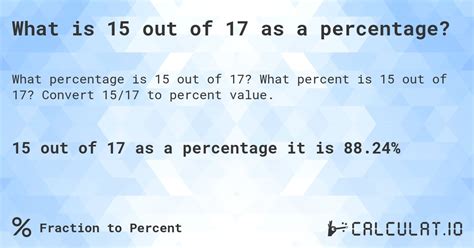15 Out Of 17 As A Percentage
Kalali
Mar 28, 2025 · 4 min read

Table of Contents
15 out of 17 as a Percentage: A Comprehensive Guide
Calculating percentages is a fundamental skill in many aspects of life, from academic assignments to professional finance. Understanding how to convert fractions into percentages is crucial for making informed decisions and interpreting data accurately. This article delves into the specifics of calculating "15 out of 17 as a percentage," providing a step-by-step guide, exploring different calculation methods, and offering practical applications. We'll also examine the concept of percentage error and its relevance in this context.
Understanding the Basics of Percentages
Before diving into the calculation, let's solidify our understanding of percentages. A percentage is a fraction or ratio expressed as a number out of 100. The symbol "%" represents "per cent," meaning "out of one hundred." For instance, 50% means 50 out of 100, or 50/100, which simplifies to 1/2.
Calculating 15 out of 17 as a Percentage: The Step-by-Step Method
To calculate 15 out of 17 as a percentage, we follow these simple steps:
-
Express the fraction: Write the given numbers as a fraction: 15/17. This represents 15 parts out of a total of 17 parts.
-
Convert the fraction to a decimal: Divide the numerator (15) by the denominator (17): 15 ÷ 17 ≈ 0.88235
-
Convert the decimal to a percentage: Multiply the decimal by 100: 0.88235 × 100 = 88.235%
-
Round to the desired precision: Depending on the context, you might round the percentage to a specific number of decimal places. Rounding to one decimal place, we get 88.2%. Rounding to the nearest whole number, we get 88%.
Therefore, 15 out of 17 is approximately 88.2%.
Alternative Calculation Methods
While the above method is straightforward, other approaches can achieve the same result. Let's explore a couple:
Method 2: Using Proportions
This method leverages the concept of proportions. We set up a proportion where x represents the percentage we're looking for:
15/17 = x/100
To solve for x, we cross-multiply:
17x = 1500
x = 1500/17 ≈ 88.235%
This confirms our previous calculation.
Method 3: Using a Calculator
Most calculators have a percentage function. Simply enter 15 ÷ 17 and then multiply by 100 to get the percentage directly. This is the quickest and most efficient method for practical applications.
Practical Applications of Percentage Calculations
The ability to calculate percentages finds widespread application across various fields:
-
Academic Performance: Calculating grades, test scores, and overall academic performance frequently involves percentage calculations. For instance, if a student answers 15 out of 17 questions correctly on a test, their score is 88.2%.
-
Finance and Business: Percentage calculations are essential in finance for calculating interest rates, discounts, profit margins, tax rates, and investment returns. Understanding percentage changes is vital for analyzing financial trends and making informed investment decisions.
-
Data Analysis and Statistics: Percentages are used extensively in representing data, comparing proportions, and interpreting statistical findings. Surveys, polls, and research studies often rely on percentages to summarize results and draw conclusions.
-
Everyday Life: We encounter percentages daily in various situations such as calculating tips in restaurants, understanding sales discounts, or determining the nutritional value of food products.
Percentage Error: A Deeper Dive
While we've calculated 15 out of 17 as approximately 88.2%, it's essential to understand the concept of percentage error. Percentage error measures the difference between an experimental or measured value and a true or accepted value. In our case, there isn't a "true" value, but we can consider the calculated percentage as an approximation. The percentage error would depend on what we're comparing it to; there's no inherent error in the calculation itself.
However, if we were using this percentage in a larger calculation or analysis where precision is critical, understanding potential error sources becomes crucial. For example, if the 17 represents a sample size, there might be sampling error. If the 15 is a measured value, there might be measurement error. These errors would propagate through our percentage calculation.
Expanding the Understanding: Working with Different Fractions
The principles demonstrated above are applicable to any fraction. To convert any fraction (a/b) into a percentage, simply divide 'a' by 'b' and multiply the result by 100. Practice with a variety of fractions will solidify your understanding of percentage calculations. For example:
- 10/20: This simplifies to 1/2, which is 50%.
- 3/4: 3 ÷ 4 = 0.75, and 0.75 × 100 = 75%
- 7/12: 7 ÷ 12 ≈ 0.5833, and 0.5833 × 100 ≈ 58.33%
Conclusion: Mastering Percentage Calculations
The ability to calculate percentages is a valuable skill with extensive applications in numerous fields. Understanding the different methods for calculating percentages, including the step-by-step approach and the use of proportions, empowers you to tackle various percentage-related problems confidently. Furthermore, appreciating the concept of percentage error allows for a more nuanced understanding of the limitations and potential inaccuracies involved in percentage calculations, especially in contexts where precision is paramount. Regular practice and application of these methods will build proficiency and confidence in handling percentage calculations effectively. Remember, accuracy and precision are key, especially when percentages are used in critical decision-making processes. The more you practice, the more comfortable and confident you'll become in applying this vital skill.
Latest Posts
Latest Posts
-
Como Se Escribe 0 En Numeros Romanos
Mar 31, 2025
-
How Many Inches Is 4 5 Feet
Mar 31, 2025
-
What Is 133 Cm In Feet
Mar 31, 2025
-
What Role Do Producers Play In An Ecosystem
Mar 31, 2025
-
Cuantos Grados Son 49 Fahrenheit En Centigrados
Mar 31, 2025
Related Post
Thank you for visiting our website which covers about 15 Out Of 17 As A Percentage . We hope the information provided has been useful to you. Feel free to contact us if you have any questions or need further assistance. See you next time and don't miss to bookmark.
